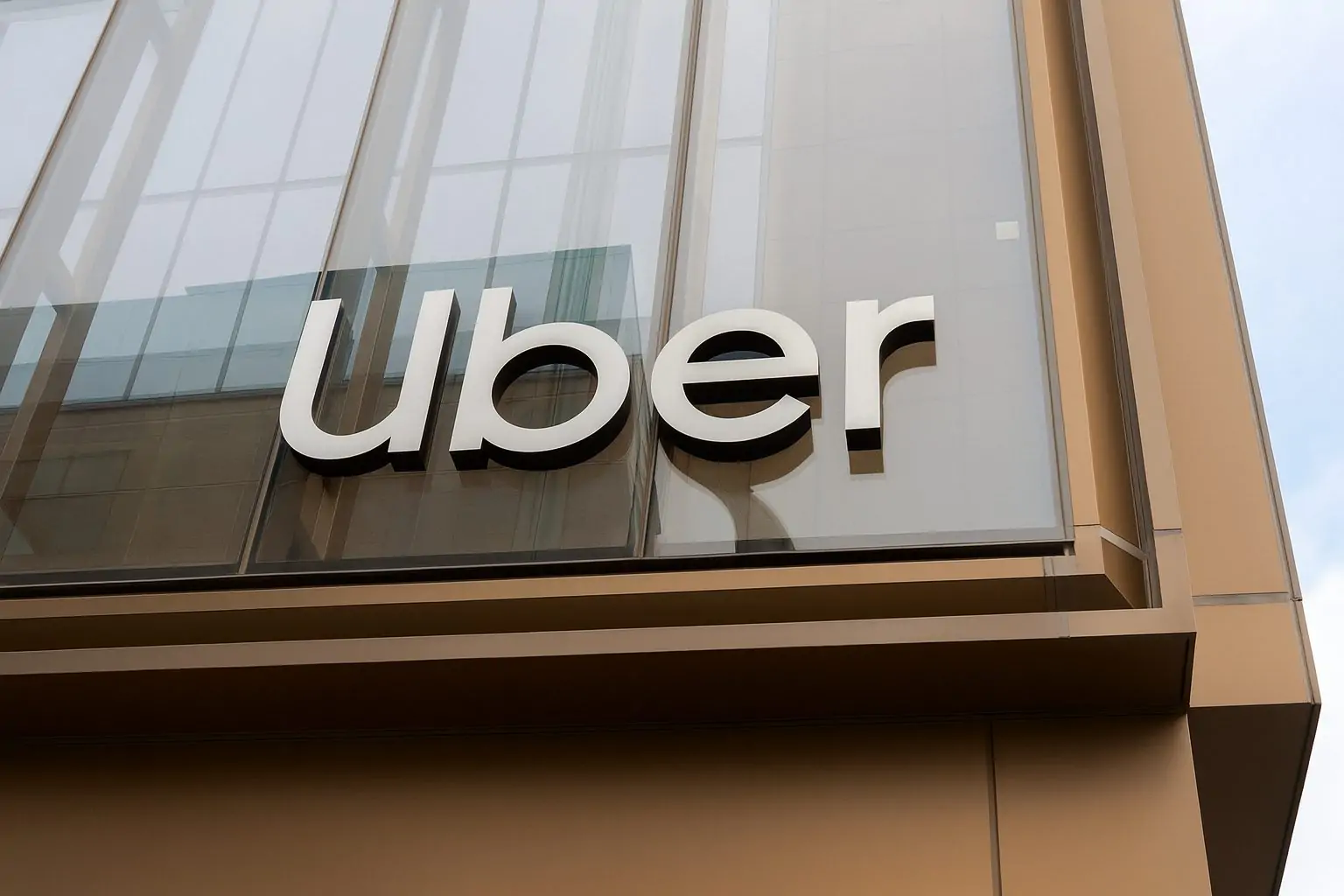As U.S. markets prepare to reopen after the Thanksgiving holiday on Friday, November 28, 2025, Uber Technologies, Inc. (NYSE: UBER) heads into the shortened trading session trading in the mid‑$80s. A fresh outlook upgrade from S&P Global Ratings, aggressive moves into robotaxis and delivery robots, and robust third‑quarter numbers are all supporting the bull case — while a growing list of legal and regulatory battles keeps risk firmly on investors’ radar. [1]
Below is what’s driving Uber stock before Friday’s U.S. market open.
Uber stock price today: Still below the highs, but well ahead of the market
Uber shares closed Wednesday, November 26, at about $85.66, up roughly 2.35% on the day. Trading volume topped 20 million shares, above the 50‑day average, and the stock finished about 16% below its 52‑week high of $101.99, set on September 22. [2]
Despite that pullback from the highs, Uber has significantly outpaced the broader market over longer timeframes. Over the past year the stock is up about 19–20%, while the S&P 500 is closer to the low‑teens. Year‑to‑date, Uber has climbed roughly 40%+, comfortably ahead of the index. [3]
In the shorter term, however, Uber has lagged. Over the last three months, shares are down about 11%, versus a gain of roughly 5% for the S&P 500, and technicals show the stock trading below both its 50‑day and 200‑day moving averages, a sign that momentum has cooled since late summer. [4]
From a valuation perspective, Uber now trades at around 11 times trailing earnings, markedly below both its own recent history and the average for internet and transportation peers, where price‑to‑earnings ratios tend to sit in the low‑20s or higher. [5] Some analysts see that compressed multiple as evidence that the market is pricing in a heavier dose of regulatory and execution risk even as profits ramp.
Short interest remains modest: about 51 million shares are sold short, roughly 2.5% of the float, with a short‑interest ratio near 3.1 days based on mid‑November data — not the kind of crowded short that typically fuels violent squeezes, but enough to add a layer of volatility. [6]
With U.S. markets closed on Thursday for Thanksgiving, pre‑market trading on Friday will be the first chance for investors to fully digest a flurry of recent headlines on ratings, autonomy and regulation. [7]
Q3 2025 earnings: Big growth, but guidance and legal charges spooked the market
Uber’s third‑quarter 2025 report earlier this month underpins much of the long‑term bullish narrative — and explains some of the recent volatility.
Headline numbers for Q3 2025: [8]
- Gross bookings: $49.7 billion, up 21% year over year
- Revenue: $13.5 billion, up 20% year over year
- Trips: 3.5 billion, up 22%, driven by 17% growth in monthly active platform consumers
- Income from operations: $1.1 billion, up 5%
- Net income: $6.6 billion, helped by a $4.9 billion tax valuation release
- Adjusted EBITDA: $2.3 billion, up 33%, with margin improving to 4.5% of gross bookings
For the fourth quarter, Uber guided to: [9]
- Gross bookings: $52.25–$53.75 billion (up 17–21% year over year)
- Adjusted EBITDA: $2.41–$2.51 billion (up 31–36% year over year)
On paper, those are strong numbers. But investors keyed in on two pain points:
- Legal and regulatory costs: Uber revealed that unpredictable “legal proceedings or governmental investigations” knocked about $479 million off its bottom line for the quarter. [10]
- Perceived softness in Q4 guidance: While still showing double‑digit growth, the outlook came in below some of Wall Street’s more bullish expectations, especially after the stock’s huge run earlier in the year. [11]
The result: shares dropped roughly 7–8% after earnings, even as analysts and many long‑term investors continued to highlight accelerating free cash flow, improving margins and the company’s first large‑scale buyback program as key positives. [12]
Heading into Friday’s session, the Q3 report still anchors the fundamental debate: is Uber now a durable cash‑generating platform with manageable legal risk, or does the legal overhang justify a persistent discount?
New growth engines: Robotaxis, delivery robots and EV expansion
Over the past two weeks, Uber has doubled down on its push into autonomous and electrified mobility — a key part of the story for investors looking beyond 2025.
Fully driverless robotaxis in Abu Dhabi
On November 26, Uber and Chinese autonomous‑driving specialist WeRide launched Level 4 fully driverless robotaxis in Abu Dhabi, with no safety driver in the front seat. It is the first time Uber has offered fully autonomous rides outside the United States. [13]
Riders requesting UberX or Uber Comfort in the covered area — initially around Yas Island — can now be matched with a WeRide robotaxi. There is also a dedicated “Autonomous” option in the app, Uber’s first AV‑only category globally. The companies plan to expand service beyond the city center by year‑end and scale the fleet toward the thousands in coming years across the Middle East. [14]
This builds on Uber’s longstanding AV strategy of partnering rather than trying to build its own hardware stack. In the U.S., Uber already offers robotaxi trips via Alphabet’s Waymo in cities like Phoenix, Austin and Atlanta, and it has inked a separate partnership with NVIDIA to help power a broader global robotaxi network. [15]
For investors, the Abu Dhabi launch is more than a photo‑op: if Uber can reliably plug third‑party autonomous fleets into its marketplace, driverless supply could eventually lower unit costs, smooth out surge pricing and strengthen the platform’s moat.
Delivery robots in the UK with Starship
On the delivery side, Uber Eats is preparing to roll out autonomous sidewalk delivery robots in the UK through a high‑profile partnership with Starship Technologies. [16]
Starting in December 2025, customers in Leeds and Sheffield will be able to receive orders from select merchants via six‑wheeled robots capable of covering about two miles in under 30 minutes. The plan is to expand across more European markets in 2026 and enter the U.S. in 2027, turning dense urban areas into testbeds for highly automated last‑mile logistics. [17]
Together with the robotaxi push, the Starship partnership signals that Uber is intent on capturing value from autonomy whether or not it ever owns the vehicles. The platform becomes the orchestrator of human drivers, AVs and robots — an attractive proposition if regulators cooperate.
EV and emerging‑market growth
Uber is also pushing its zero‑emissions strategy. In South Africa, the company just launched its first fully electric car service in the country, aligning with its goal of achieving a zero‑emission platform globally by 2040 and supporting more affordable urban transport. [18]
At the same time, Uber plans to resume operations in Morocco, relaunching services in Casablanca and Marrakech ahead of the Africa Cup of Nations — another sign the company is leaning into high‑growth emerging markets where ride‑hailing penetration is still relatively low. [19]
These moves give the bull camp more to point to than just cost‑cutting and buybacks; they suggest Uber is still very much in expansion mode.
Ratings and Wall Street sentiment: S&P turns positive, analysts stay bullish
One of the biggest headlines for Uber investors this week came from the credit side rather than the equity desk.
S&P Global Ratings shifts Uber’s outlook to “positive”
On November 26, S&P Global Ratings revised Uber’s outlook to “positive” from “stable”, while affirming its BBB long‑term credit rating. [20]
The agency cited:
- Strong organic growth in gross bookings
- Rising profitability and cash‑flow generation
- The expectation that Uber can continue to de‑lever and maintain a solid liquidity profile while investing in new areas like autonomy
A positive outlook doesn’t guarantee an upgrade, but it signals that if Uber continues to execute on its plan, a higher rating is plausible over the next couple of years — potentially lowering funding costs and boosting investor confidence in its balance sheet.
Equity analysts: Double‑digit upside still the consensus
On the equity side, the Street remains broadly bullish:
- Bank of America Securities recently reiterated a Buy rating on Uber and set a $119 price target. [21]
- Across major brokerages, the average 12‑month price target clusters around $108–$109, implying about 25–27% upside from the current share price in the mid‑$80s. [22]
- Most firms rate the stock a “Buy” or “Strong Buy,” with only a handful of Holds and virtually no Sells. [23]
Zacks and other quantitative services highlight Uber as a “strong growth stock,” noting that at least a dozen analysts have raised earnings estimates in recent weeks, pushing the 2025 consensus EPS above $5 per share and extending a track record of large positive earnings surprises. [24]
Put together, the rating upgrade, robust free‑cash‑flow profile and still‑optimistic analyst community provide a supportive backdrop for the stock as it heads into Friday’s session — even if recent price action has been choppy.
Legal, regulatory and labor risks: The main brake on sentiment
If growth and autonomy are the accelerators for Uber stock, legal and regulatory risk is the brake — and it’s being pressed from several directions.
Lawsuits, investigations and safety headlines
- The U.S. Department of Justice sued Uber in September, alleging discrimination against passengers with service animals and wheelchairs under the Americans with Disabilities Act. The government is seeking policy changes, training and monetary penalties. [25]
- Multiple sexual assault and safety‑related lawsuits remain outstanding, including new cases filed in Texas and other states, along with litigation over women‑only ride features that some male drivers say are discriminatory. [26]
- In Australia, regulators fined Uber roughly A$250,000 after discovering that dozens of Uber Eats drivers — who lacked the proper licenses — had been transporting passengers, underscoring ongoing compliance issues in key markets. [27]
- Across multiple countries, recent high‑profile incidents involving riders and drivers have kept safety concerns in the public eye, reinforcing pressure on Uber to tighten standards and invest in protections. [28]
Uber’s own earnings commentary makes clear that these issues are not just reputational but also financial, with hundreds of millions in quarterly charges tied to legal and regulatory matters. [29]
Algorithmic pay and worker‑status challenges
Uber is also grappling with challenges to its algorithmic pay systems and driver classification:
- In Europe, a non‑profit foundation has accused Uber of using AI‑driven pay algorithms that allegedly harm driver incomes and violate data‑protection rules, with potential collective legal action planned in the Netherlands. [30]
- In New Zealand, the country’s Supreme Court recently ruled that four Uber drivers were employees while logged into the app, not independent contractors. That decision doesn’t directly change laws elsewhere, but it adds momentum to global efforts to reclassify gig workers, which could raise labor costs if replicated in larger markets. [31]
Antitrust and pricing scrutiny
Closer to home, a proposed class‑action suit in U.S. federal court alleges that several taxi‑hailing apps colluded — via integrations with Uber — to inflate ride prices and reduce competition. Uber itself is not named as a defendant, but its 2022 integration deals with traditional taxi apps sit at the heart of the complaint, keeping antitrust questions alive. [32]
For equity investors, the big unknowns are timing and magnitude: when will these cases resolve, and will they result in one‑off fines, ongoing higher operating costs, structural changes to Uber’s model, or some mix of all three?
Ownership trends: Institutions add, selective selling continues
Recent regulatory filings show that institutional investors remain heavily involved in Uber:
- The State Board of Administration of Florida Retirement System recently increased its stake by about 0.7% to nearly 2 million shares, valued around $184 million, helping push overall institutional ownership of Uber above 80%. [33]
- At the same time, Bell Asset Management cut its position by roughly 28% in the second quarter, though Uber still ranks among its larger holdings. [34]
Combined with relatively low short interest, this pattern suggests a market where big investors are rebalancing positions rather than abandoning the name — a dynamic that can amplify both up and down moves on news days like Friday.
What to watch for Uber stock before Friday’s open
Heading into the November 28, 2025 U.S. session, Uber’s setup is a mix of strong fundamentals, ambitious new growth bets and persistent legal drag. Key angles traders and longer‑term investors may focus on include:
- Reaction to the S&P outlook upgrade
Does the positive outlook and affirmed BBB rating attract more long‑only and credit‑sensitive investors, or is it already priced in after Wednesday’s bounce? [35] - Follow‑through on recent price strength
After a 2.35% gain Wednesday but a three‑month downtrend overall, watch whether Uber can hold the mid‑$80s and begin to reclaim technical levels, or whether sellers fade the post‑holiday rally. [36] - Further news on robotaxis and delivery robots
Any early usage data, geographic expansion updates or regulatory commentary from Abu Dhabi or UK authorities could sharpen estimates around the revenue and margin impact of autonomy. [37] - Legal & regulatory developments
With multiple lawsuits and investigations progressing in the U.S., Europe, Oceania and elsewhere, surprise headlines about settlements, fines or policy changes remain a risk catalyst in either direction. [38] - Macro and holiday‑week liquidity
Friday’s session comes after a full market holiday and in the middle of the Thanksgiving–Black Friday shopping window, when liquidity can be thinner and moves in large‑cap growth names like Uber can be amplified.
Uber enters Friday’s open as one of 2025’s standout tech‑adjacent winners, trading at a modest earnings multiple for a company still delivering 20‑plus‑percent growth and expanding into robotaxis, delivery robots and electric mobility. [39]
Whether the next leg is higher or lower will likely hinge on a familiar tension: can Uber convert its expanding global footprint and autonomous partnerships into sustained, low‑risk cash flows faster than regulators, courts and public opinion raise the cost of doing business?
This article is for informational purposes only and does not constitute investment advice or a recommendation to buy or sell any securities.
References
1. www.investing.com, 2. www.marketwatch.com, 3. markets.financialcontent.com, 4. markets.financialcontent.com, 5. public.com, 6. finance.yahoo.com, 7. www.timeanddate.com, 8. investor.uber.com, 9. investor.uber.com, 10. fortune.com, 11. www.reuters.com, 12. www.reuters.com, 13. www.reuters.com, 14. www.businesswire.com, 15. nvidianews.nvidia.com, 16. www.reuters.com, 17. www.reuters.com, 18. iol.co.za, 19. barlamantoday.com, 20. www.investing.com, 21. finance.yahoo.com, 22. www.marketbeat.com, 23. stockanalysis.com, 24. www.nasdaq.com, 25. www.justice.gov, 26. www.lawsuit-information-center.com, 27. www.dailytelegraph.com.au, 28. news4sanantonio.com, 29. fortune.com, 30. www.theguardian.com, 31. www.lexology.com, 32. www.reuters.com, 33. www.marketbeat.com, 34. www.marketbeat.com, 35. www.investing.com, 36. www.marketwatch.com, 37. www.reuters.com, 38. www.justice.gov, 39. investor.uber.com









